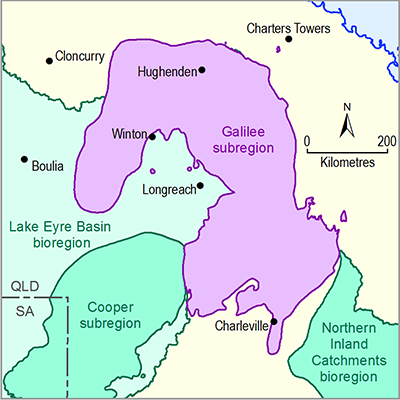Page 28 of 44
There have been limited studies of surface water – groundwater interactions in the Belyando and Thomson river basins. A number of assumptions were required in order to make the computations outlined in this section and discussions on data gaps are outlined in companion product 3-4 for the Galilee subregion (Lewis et al., 2018). However, information that would assist in gaining a better understanding of the surface water – groundwaterinteractions includes:
- streamflow gauge data acquired by coal mining proponents, in particular for the Carmichael River
- thickness maps for alluvium and Paleogene-Neogene sediments
- more hydraulic parameter measurements, in particular in the vicinity of river reaches of interest such as the Thomson River. For example, hydraulic conductivity
- time-series bore hydrograph data covering more than a couple of years
- access to at least some company coal bore data would greatly improve the accuracy of geological models in the vicinity of coal exploration areas and proposed coal development. Not all bore data would be required. Primarily well location data, stratigraphic picks and if possible some geophysical well logs. Data from near-surface portion of the well logs would be useful for more detailed characterisation of lithological variation of the alluvium, Paleogene–Neogene sediments and their relationship to underlying geological units
- river bed profiles for river reaches of interest
- improved understanding of distribution of buried paleochannels
- monitoring bores in alluvium and Paleogene–Neogene sediments near major drainage channels and particularly near streamflow gauges if located in the Galilee subregion
- hydrochemistry and isotopic data from shallow groundwater systems in alluvium and Paleogene–Neogene sediments and surface water
- investigations utilising remote sensing data e.g. Landsat. These data could be used to delineate GDEs or fluxes of water in landscape with time
- knowledge of the thickness, structure and lithological variations within Cenozoic sequences is very limited across the Galilee subregion. One option that would improve understanding of the Cenozoic sediments would be acquisition of airborne electromagnetic (AEM) data in the subregion. If required, the AEM survey could be complemented by a shallow drilling programme or use of existing company-supplied drilling data (if applicable), to provide stratigraphic control for modelling the thickness and characteristics of the near-surface cover. The AEM data would also provide information on shallow groundwater systems, and potentially identify areas of connectivity between Cenozoic cover and underlying regional GAB aquifers.
Last updated:
6 December 2018

Summary and download
Product Finalisation date
2018
PRODUCT CONTENTS
- 2.1.1 Geography
- 2.1.2 Geology
- 2.1.3 Hydrogeology and groundwater quality
- 2.1.4 Surface water hydrology and water quality
- 2.1.5 Surface water – groundwater interactions
- 2.1.6 Water management for coal resource developments
- Citation
- Acknowledgements
- Currency of scientific results
- Contributors to the Technical Programme
- About this technical product
ASSESSMENT
ASSESSMENT COMPONENT
